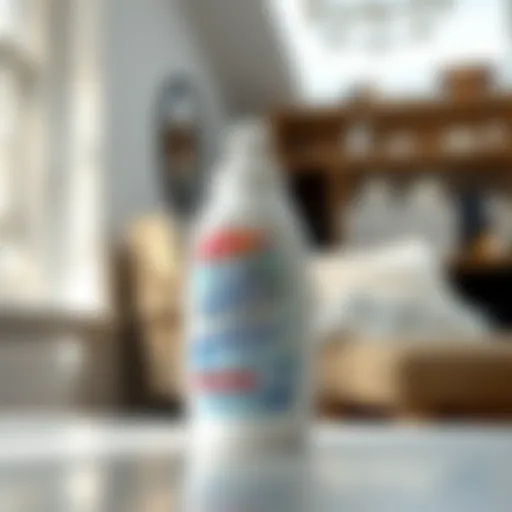Understanding Bathroom Tiling Costs: A Comprehensive Guide
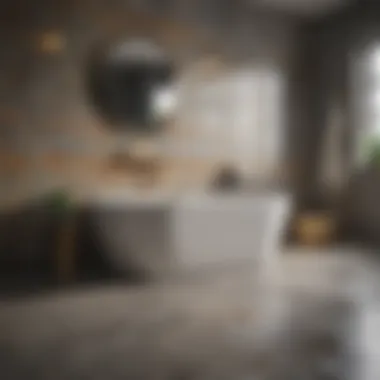

Intro
Tiling a bathroom is no mere afterthought—it's a significant investment that can elevate the overall aesthetic and functionality of your space. Whether you’re splurging for a luxurious retreat or simply updating a well-worn area, understanding the costs associated with tiling is crucial. When it comes to budgeting, several factors come into play, including materials, labor, and design preferences. This article will guide you through these considerations, focusing on the essence of each element. By the end, you’ll be well-equipped to make informed choices that align with your vision and wallet.
Trending Styles
When contemplating a tiling project, it’s important to consider current design trends. The style you choose not only reflects your personal taste but can also influence the overall cost of materials and installation. Here’s a peek at two particularly sought-after styles:
Modern Minimalism
The essence of modern minimalism lies in simplicity and functionality. This trend often features sleek lines, unadorned surfaces, and a limited color palette. Choosing large format tiles in muted shades, like soft greys and whites, reduces grout lines while creating a seamless look. The beauty of modern minimalism is that it may require fewer materials and less labor-intensive installation, which can ultimately keep costs in check.
Cozy Rustic
On the flip side, if you hanker for a warmer, inviting feel, rustic styles can be your ticket to creating that cozy haven. Authentic materials such as terracotta or reclaimed wood tiles add character. However, these materials might come with a heftier price tag and can also increase labor costs, particularly if the installation requires a specialized approach. Incorporating elements like textured or patterned tiles can create an eye-catching focal point for your bathroom.
Color Palettes
Aside from style preferences, color choices can significantly affect your tiling budget as well. The hue you opt for plays a pivotal role in setting the mood and can even dictate what materials you'll be able to afford.
Calming Neutrals
Neutral colors are all the rage for bathrooms, as they exude tranquility. Think shades like beige, soft taupe, or light greys. These not only create a calm ambience but are versatile enough to match with various accessories and fixtures. The materials in these tones may range from cost-effective ceramic tiles to more luxurious porcelain, allowing you to work within a budget while still achieving a chic look.
Bold Accents
Conversely, introducing bold, statement colors—like deep blues or vibrant greens—can bring energy into a bathroom. While they make a remarkable visual impact, keep in mind that these shades can sometimes require specialized tiles, which could hike up your overall expenses. It’s important to assess whether you want a pop of color as an accent or as the predominant theme, as this decision can shape your purchasing approach.
"The balance between style and budget is an artful dance; understanding your options can help you step to the right beat."
Prelims to Bathroom Tiling Costs
Bathroom tiling is not just about adding a pretty face to your space; it plays a crucial role in both functionality and aesthetics. Understanding the costs associated with this renovation project is essential for homeowners. With so many factors at play, having a clear grasp of the expenses can mean the difference between a successful transformation and budget overruns that leave you feeling drained.
Overview of Tiling in Bathroom Renovations
When embarking on a bathroom renovation, tiling often stands as a focal point. It provides an opportunity to express your personal style through choices in design and color. Ceramic, porcelain, vinyl – the options are nearly endless, and each comes with its unique set of costs. Tile not only enhances the look of your bathroom but also contributes to its durability and ease of upkeep. A well-tiled bathroom can resist moisture better than paint or wallpaper, making it a practical choice.
Diving deeper into the choices available, it’s critical to consider factors like size and layout. For example, using larger tiles can sometimes minimize grout lines, giving a seamless appearance, while smaller tiles offer intricate patterns or textures. Each type of tile, whether it’s ceramic or natural stone, offers different price points and requires different installation techniques, which can further impact your overall budget. So, it is vital to weigh the pros and cons of each option carefully.
Importance of Understanding Costs
Getting a handle on the costs tied to bathroom tiling can prepare you for the financial commitment required. Without a proper understanding, it’s easy to underestimate expenses, leading to unwelcome surprises as the project progresses. Here are some things to keep in mind:
- Material Choices: The type of tiles you inevitably choose can shift your budget significantly. Natural stone tends to cost more than vinyl but offers unique beauty.
- Labor Costs: Hiring a professional will add to your expenses, while DIY can save you money, but it may require your time and skill.
- Additional Costs: Underlayment, adhesives, grouting, and disposal of old materials require consideration in your budget. These incidental expenses can really add up if you’re not careful.
"Before you start, have a clear plan - stick to a budget that allows for some wiggle room."
Understanding these various aspects puts you in a stronger position to make informed decisions. It helps strip away the guesswork involved in budgeting for your bathroom tiling, enabling you to effectively allocate resources toward what matters most. Being informed translates directly to your satisfaction with the results.
Being cognizant of these details can also lead to better conversations with contractors if you choose to hire help, ensuring everyone is on the same page. So, as you step into this project, remember that clarity in costs and expectations will pave the way for a smooth tiling experience.
Material Costs
Understanding the material costs in tiling a bathroom is a cornerstone for proper budgeting. The choice of materials can significantly affect the overall expenses of the project and dictate the aesthetic appeal and functionality of the space. This section runs through the different types of tiles available, their price ranges, and how various factors such as size, thickness, and design intricacies play into the final figures. By grasping these dynamics, homeowners can make informed decisions and avoid nasty surprises when it comes to their bathroom tile project.
Types of Tiles and Their Pricing
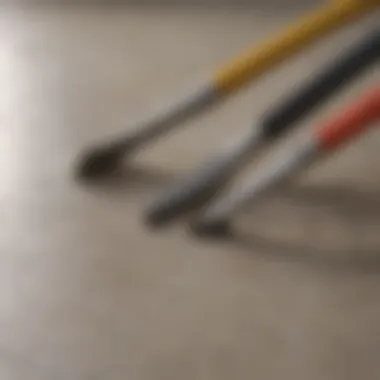

Ceramic Tiles
Ceramic tiles have a long-standing reputation in bathroom renovations, mainly due to their affordability and versatility. The key characteristic of ceramic tiles is their ease of maintenance; they come glazed or unglazed, and both options have advantages. For instance, glazed ceramic tiles are less porous, meaning they are less likely to stain, making them an ideal fit for a room that often deals with moisture.
One unique feature of ceramic tiles is their wide variety of designs. Homeowners can find numerous colors, sizes, and textures, catering to different tastes and styles. However, while ceramic tiles are a solid choice, they can be less durable than porcelain or natural stone, and they might chip if something heavy falls on them.
Porcelain Tiles
Porcelain tiles, while a bit pricier than their ceramic counterparts, are well-known for their durability and water resistance. One significant aspect of porcelain tiles is they are fired at higher temperatures, leading to a denser and tougher tile. This characteristic makes them a popular choice for both flooring and wall applications in bathrooms.
The unique feature of porcelain tiles is their ability to mimic natural stone or wood, offering the aesthetic appeal of those materials at a lower cost and with increased durability. On the flip side, their installation can be more taxing, requiring specialized tools, which might contribute to higher labor costs if a professional is hired.
Natural Stone Tiles
When it comes to natural stone tiles, there's a certain prestige associated with them. Known for their luxurious look and feel, these tiles can elevate the aesthetic of any bathroom. One of the key characteristics of natural stone tiles is their uniqueness; no two pieces are identical, giving each installation a distinct flair.
These tiles often come with higher price tags, not only for the tiles themselves but also for the installation. Natural stone tiles require sealing to avoid moisture absorption and staining, which can add further costs. While they are certainly elegant, the upkeep can also be more involved, which may deter some homeowners.
Vinyl Tiles
Vinyl tiles might not have the same glamorous reputation as ceramic or stone options, yet they remain a highly practical and budget-friendly choice. The main draw of vinyl tiles is their affordability and ease of installation, appealing to DIY enthusiasts.
Vinyl tiles come in various styles and designs, some even mimicking more expensive materials. A unique feature of vinyl tiles is their comfort underfoot, providing a softer surface to stand on in comparison to harder tiles. However, one disadvantage is their susceptibility to scratching and denting, making them less ideal for high-traffic areas.
Impact of Tile Size and Thickness on Costs
The size and thickness of tiles can make or break a budget. Larger tiles often cost more per square foot but may reduce installation time since fewer pieces need to be laid down. On the other hand, thick tiles, while offering durability, may necessitate additional underlayment or adjustments that can drive the overall cost up.
Pattern and Design Complexity Costs
The complexity of tile patterns and designs can hike costs significantly. Intricate layouts often require more precise cutting and alignment, which directly translates to higher labor rates. This factor should be taken seriously while planning; a simple straight lay can save a considerable amount versus a herringbone or mosaic design.
Labor Costs
Labor costs are a critical component when tackling bathroom tiling projects. They often make up a substantial portion of the overall budget and can greatly influence your choices, both in terms of financial outlay and project timelines. Understanding these costs enables you to compare hiring professionals with potential DIY approaches effectively. In short, labor can be a dealbreaker when it comes to staying within budget or achieving desired quality.
Hourly Rates for Professional Tilers
When considering professional help, it's essential to be aware of the going rates for tilers. Typically, you might find that professional tilers charge between $40 and $150 per hour. The variance depends on several factors such as their skill level, the complexity of the work involved, and even regional differences in cost of living. For instance, hiring a tiler in New York City may cost significantly more than in a rural area, mainly due to demand and cost of living. Thus, knowing the average rates in your area can help you flatten the learning curve while budgeting.
Factors Affecting Labor Costs
Location
The geographical area where you live plays a significant role in shaping labor costs. Major cities usually see higher rates to compensate for the increased cost of living. For example, hiring a tiler in San Francisco will pinch your wallet much more than a similar service in a small town in Ohio.
Additionally, urban centers often have access to a larger pool of skilled tradespeople, which can mean higher competition and potentially lower costs, but still, the demand keeps rates elevated. It’s crucial to match your budget with the local market by getting multiple quotes to find a fair deal.
Experience Level
The expertise of a tiler profoundly impacts the price you’ll pay. Master tilers, with years of experience and specialized skills, can command higher rates. This investment may pay off in the long run through better quality of work and fewer mistakes. For instance, someone with just one year of experience may offer you a significantly lower rate than a seasoned professional, but those savings might come at the risk of poor installation, potentially leading to costly repairs down the road. A classic case of "you get what you pay for" rings true here.
Project Scope
The overall scale and complexity of your tiling project can greatly influence labor costs. A bathroom with numerous angles, intricate patterns, or custom designs demands time and expertise, pushing up total labor rates. Conversely, a simple, straightforward layout will likely involve less time and lower costs. When planning your project, consider not only the square footage but also any unique features that might require more skilled work.
DIY vs. Hiring Professionals
Weighing the pros and cons between DIY and professional help is crucial. On one hand, rolling up your sleeves and tackling a bathroom tiling project can save a decent chunk of change. However, the risks can be considerable. If you don't have prior experience, the likelihood of making costly mistakes increases. Furthermore, the time needed to master techniques might be longer than anticipated, making that DIY project feel like an uphill battle.
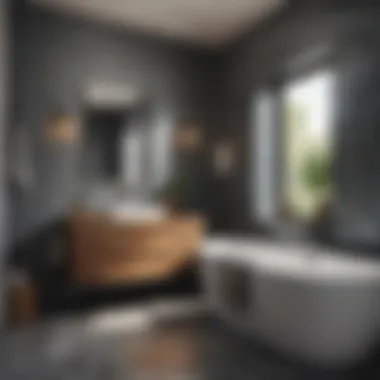

On the flip side, hiring a seasoned pro can alleviate stress and ensure that the job is done right the first time. Any savings you might have realized through DIY efforts can quickly evaporate if the job isn't up to par, leading to potential health hazards, like mold from improper installation. So, evaluating your own abilities and the complexity of the project will help guide your ultimate choice.
Additional Costs to Consider
When embarking on a bathroom tiling project, it’s easy to get lost in the numbers, focusing primarily on materials and labor. However, overlooking additional costs can lead to budget blowouts that may catch you off guard. Understanding these unexpected expenses is crucial in crafting a comprehensive budget and setting realistic expectations.
These additional costs are influential in shaping the overall financial landscape of the project. They encompass a wide range of components, such as preparation work, materials necessary for installation, and even the disposal of old tiles. By addressing these costs up front, you not only save yourself from unpleasant surprises but also enhance the overall quality and longevity of your tiling project.
Preparation and Underlayment Expenses
Preparation is key to achieving that picture-perfect finish you desire in your bathroom. Before a single tile can be laid, the surface must be adequately prepared, and often, this means investing in an underlayment. This layer helps create a stable foundation for tiles, reducing the risk of cracking and ensuring a smooth installation.
The type of underlayment you choose also adds an extra layer of expense.
- Cement Board: This is commonly used in wet areas and generally costs a bit more but provides excellent waterproofing.
- Membrane Systems: For those looking for the best seal, a membrane system could be the right choice, though it comes with a higher price tag.
Neglecting this step can lead to more headache further down the line. Tile not adhering properly or, worse, damaging over time can eat away at your savings—turning those initial dollars saved into a costly endeavor.
Grout and Adhesives Costs
Grout and adhesives may not be the most exciting aspects of tiling, but they are undeniably vital and can add significantly to your expenses. The quality of these materials affects both appearance and durability.
- Adhesives: Thin-set mortars typically range from budget-friendly options to specialized formulations for high-moisture areas. The price can swing based on the type and brand.
- Grout: Traditional grout may come cheap, but consider choosing epoxy or other high-performance types for areas with heavy moisture or heat exposure.
Remember that these products play a pivotal role in ensuring a robust and lasting installation. As they say, you get what you pay for, and opting for cheaper alternatives might lead to costly fines in repairs and replacements sooner than you'd like.
Removal and Disposal of Old Materials
If you're renovating rather than starting fresh, the expense of removing old tiles and materials can creep into your budget. This phase is sometimes underestimated.
- Labor Costs for Removal: If you’re hiring professionals, this can increase your overall tiling expenses. Hiring laborers to square away previous installations can run you anywhere from $1.50 to $4.00 per square foot—make sure you get a precise quote.
- Disposal Fees: Don’t forget about the cost of disposing of old materials, which can be hefty, especially in urban areas where landfill charges apply.
Taking a moment to account for these costs will save you from the shock of seeing the final bill.
Finishing Touches: Trim and Sealant
Don’t overlook the finishing touches that can elevate your tiling project from simple to sensational.
- Trim: Whether you opt for bullnose tiles or traditional metal trims, the costs can add up depending on materials and style. Choose wisely to harmonize with the overall design yet remain within your budget.
- Sealant: Especially important for natural stone tiles, a good sealant protects against water damage and staining. The price for sealants can vary based on quality and the area you need to cover.
"A well-finished job is as good as a well-planned job. Ignoring these finishing touches can lead to regret."
In summary, realizing the importance of additional costs in tiling a bathroom can guide you in creating a more accurate budget and ultimately achieving the bathroom of your dreams without breaking the bank.
Estimating Your Total Costs
Estimating costs accurately is a crucial step in any tiling project. Without a proper estimate, it’s easy to find yourself in a financial pickle, especially if unexpected expenses pop up. Having a ballpark can guide decisions that enable you to stay within your budget without sacrificing quality. It is essential to break down the costs into manageable chunks, which not only simplifies the process but also sheds light on where you can cut corners without compromising the finished product.
Calculating Material and Labor Estimates
To get an accurate estimate for your tiling project, one must look closely at the materials and labor. Material costs can vary tremendously based on your choice of tiles and the area that needs tiling. Here’s how to approach this:
- Choose Your Tiles Wisely: You often have a wide range of options; from ceramic to natural stone to vinyl. Depending on style preferences, the overall look can vary significantly.
- Calculate Area Size: Break out the measuring tape and determine the total area you plan to tile. This basic number is pivotal for calculating how much tile to buy. Remember to account for waste, as it's always wise to order about 10% extra.
- Labor Costs: Hiring professionals can range anywhere from $4 to $12 per square foot, depending largely on location, experience, and project complexity.
- Total Calculation: Add the material costs to the estimated labor costs (materials + labor). For example, if you have 100 square feet and decide on $5 per square foot for tiles, your material cost would be $500. If labor runs you $8 per square foot, that’s another $800. Thus, your total would come to about $1300.
- For instance, sportier ceramic tiles might set you back only $1 to $5 per square foot, while luxurious natural stones can be as steep as $10 to $30 or even more.
Calculating both material and labor estimates gives you a clearer picture of where your budget stands, making it easier to make informed decisions moving forward.
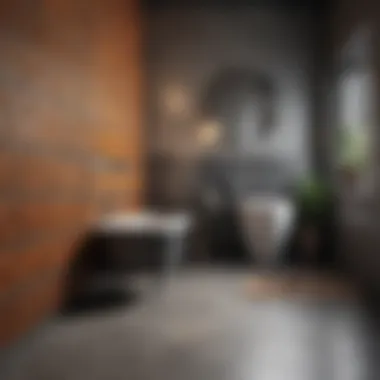

Creating a Budget for Your Project
Budgeting is the backbone of any home renovation project. With a clear figure in mind, you eliminate the guesswork and can prioritize your spending. Here are some helpful pointers:
- Set Your Maximum Limit: Understand your financial boundaries right from the get-go. Setting a maximum amount that you’re willing to spend will aid in decision-making.
- Break Down the Budget: Create categories for your spending like materials, labor, and unexpected costs. A common rule of thumb is to allocate around 10% of your budget for surprises.
- Consider Alternative Materials: If the costs are spiraling, consider substituting higher-end materials with budget-friendly options that mimic the original look.
- Keep an Eye on Labor: If you’re leaning towards a DIY approach, factor in the time investment as well. Don't forget to factor in potential costs of tools or equipment rentals.
"Budgeting for a home project is like setting up a roadmap; you can see the route ahead and know when to change direction if needed."
By sticking to your budget, you keep the project streamlined and avoid the dreaded financial hangover that comes from overspending. Embracing clear calculations and understanding the fundamentals of project budgeting not only prepares you but also empowers you to create the beautiful bathroom you’ve envisioned.
Tips for Reducing Bathroom Tiling Costs
Reducing bathroom tiling costs can feel like a daunting task; however, it is crucial to approach it with a clear strategy and awareness. In a world where budgets are tight and costs can spiral out of control, finding ways to cut expenses without sacrificing quality is essential. This section will explore practical tips that can help you navigate the financial aspect of your bathroom tiling project while still ensuring a beautiful and functional result.
Choosing Budget-Friendly Materials
When it comes to tiles, the materials you select can make a world of difference in the cost. Opting for budget-friendly materials does not mean you have to settle for something that looks cheap or poorly made. For instance, ceramic tiles tend to be more affordable compared to natural stone tiles, which can be much pricier.
Here are some options to consider:
- Ceramic Tiles: These are not only budget-friendly but also versatile in terms of design and color.
- Vinyl Tiles: If you’re looking for an inexpensive yet attractive option, vinyl tiles can mimic the look of high-end tiles at a fraction of the price.
- Porcelain Tiles: Although a bit pricier than ceramic, affordable porcelain tiles can still be found and offer a durable option for wet areas.
Taking time to research local suppliers and compare prices online can also strik a beneficial deal. Keep an eye out for sales or clearance items at home improvement stores, as these can sometimes yield significant savings.
Maximizing DIY Efforts
While hiring professionals may be the most obvious route, taking on some of the work yourself can drastically lower your costs. DIY efforts might seem intimidating, but with the right tools, resources, and a pinch of determination, many homeowners find they can handle the tiling process themselves.
Start by familiarizing yourself with basic tiling techniques. There are countless videos and articles available online that offer step-by-step guidance. Just consider the following:
- Preparation: Take the time to prepare the space adequately. Removing old tiles and cleaning the surface can be done over a weekend.
- Learning and Practice: Practicing on a small section can help you gain confidence before tackling the larger area.
- Enlisting Help: Don’t forget to ask friends or family who may have experience. They can offer insights or lend a hand when needed.
However, it’s vital to know your limits; if you encounter intricate patterns or large spaces, it could be wise to call in professionals to avoid costly mistakes.
Timeframe Considerations for Cost Efficiency
Timing can also play a crucial role in managing costs. By planning your renovation during certain periods, you might find materials and labor to be significantly cheaper. Here are some time-based considerations:
- Off-Peak Seasons: Consider doing your renovation during off-peak seasons when contractors might reduce their pricing to fill their calendar.
- Project Planning: Set a clear timeline to avoid delays which can lead to increased costs. Missing deadlines often results in additional labor fees or rushed work.
Moreover, prioritize your renovation tasks—sometimes waiting to purchase tiles until the right deal comes along can save you a hefty sum.
“Proper planning and timing make all the difference in managing your tiling project costs effectively.”
Reducing costs during a bathroom tiling project is not merely about selecting cheaper materials or labor; it involves a thoughtful approach to budgeting and planning. By carefully choosing your materials, embracing DIY efforts, and being strategic about your timing, you can significantly cut down on unnecessary expenses.
Closure
Tiling a bathroom involves many costs and considerations. Understanding these is essential for anyone looking to embark on such a project. You don't want to jump in blind and end up with a wallet that feels lighter than a feather.
Summary of Key Cost Factors
At the end of the day, a few key factors really drive the costs associated with bathroom tiling. Firstly, material selection plays a huge role. The type of tiles you choose—be it ceramic, porcelain, or natural stone—can vary widely in price. For instance, while ceramic tiles are generally on the more affordable side, natural stones like marble or granite can make your budget scream.
Next up is labor costs. Whether you decide to go the DIY route or hire a professional can significantly impact your final tally. Pros bring expertise but also a price tag. It’s wise to weigh the benefits of their experience against the potential savings if you do it yourself, provided you can handle the complexities.
Furthermore, don’t overlook additional costs like preparation or disposal of old tile. They might seem like small potatoes compared to the overall project cost, but every little bit adds up, and it could surprise you when you add up the receipts.
Encouragement for Informed Decision Making
Always remember that shoddy planning can lead to overspending or, worse, corners cut on quality, which can haunt you in the long run. Develop a detailed budget and don’t shy away from seeking out multiple quotes if you choose to hire professionals. By doing so, you create a safety net against unforeseen costs and make well-informed choices that reflect your needs and desires.
"It’s better to measure twice and cut once than to jump in head-first only to find out you’re in over your head."
Ultimately, the key to a successful tiling project lies in careful consideration and planning. Nurturing these elements will lead to a bathroom transformation that’s not only stunning but also financially sound.



